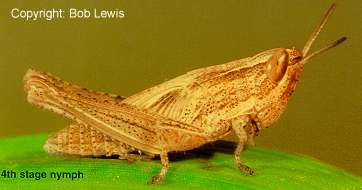Nymph description 13 of 15

Distribution

Nymph Description: The colour is brown to green in early stages and more green in later ones. In profile the head has a very distinctive shape where the line of the top comes to a point before turning down along the face. From above this looks like a point forward of and between the eyes - more distinctive in early instars. There is a general lighter stripe along the top of the body but it becomes less prominent with age. No 'X' or distinctive marks on the top of the thorax. Early instars have a dark mark on the second wing bud but in later instars this becomes less distinct and part of a general darker smudge on the side from the eye to mid-abdomen.
Confusion with Australian plague locust: General size and shape only (compare photos).
Confusion with Bermius: Similar slim often green body.Unique features: The combination of a pointed (from above) and sharp angled (from the side) head with an elongate relatively skinny body, lighter coloured on top with a darker smudge along most of the side in late instars. It also lacks the 'X' on top of the thorax.
Further information on this species: Description of adult
